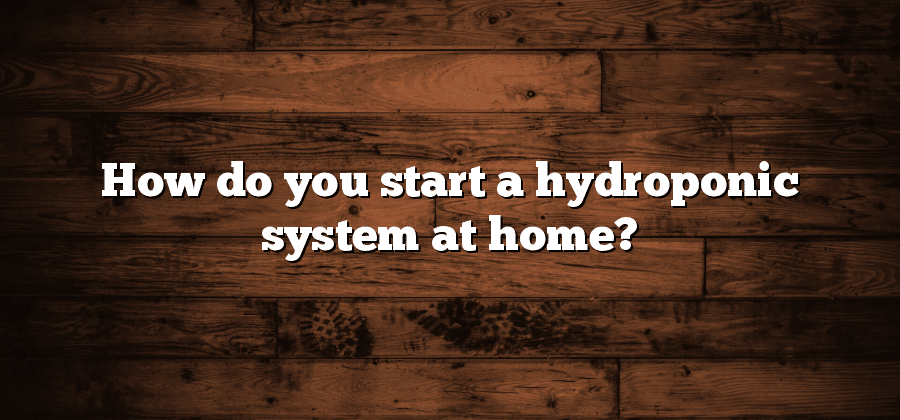Benefits of Hydroponic Gardening
Hydroponic gardening, a method of growing plants without soil, offers numerous benefits for aspiring gardeners. First and foremost, this technique allows for year-round cultivation, making it possible to grow plants regardless of the climate or season. This is particularly advantageous for individuals living in regions that experience extreme temperatures or limited sunlight. Additionally, hydroponic gardening promotes efficient water usage as it requires up to 90% less water compared to traditional soil-based gardening methods. This not only helps conserve this precious resource but also reduces the overall cost of maintaining a garden.
Moreover, hydroponics eliminates the need for chemical fertilizers and pesticides, providing a healthier and more eco-friendly approach to gardening. By controlling the nutrient levels and pH balance directly in the water, gardeners can ensure that their plants receive optimal nourishment without the risk of harmful pollutants. Furthermore, the absence of soil also mitigates the threat of soil-borne diseases and pests, reducing the need for chemical interventions. This not only promotes a safer and more sustainable growing environment but also produces healthier and more nutritious plants.
Choosing the Right Hydroponic System
When it comes to choosing the right hydroponic system for your gardening needs, there are several factors to consider. One of the first things to think about is your available space. If you have limited area, a vertical hydroponic system can be a great option as it maximizes the use of vertical space. On the other hand, if you have a larger area and want more flexibility in terms of plant varieties and quantities, a horizontal NFT (Nutrient Film Technique) system might be a better choice.
Another important factor to consider is your level of experience and expertise. Some hydroponic systems, such as the Wick system or the Kratky method, are relatively simple and require minimal monitoring and maintenance. These systems are great for beginners or those with limited time to devote to gardening. However, if you’re a more experienced gardener or have a keen interest in technology, an aeroponic or recirculating system may suit you better. These advanced systems allow for precise control over nutrient delivery and are ideal for maximizing plant growth and yield.
Essential Equipment for a Home Hydroponic System
Hydroponic gardening offers a unique and innovative way to grow plants without the use of soil. To successfully set up a home hydroponic system, it is crucial to have the right equipment. The essential equipment for a home hydroponic system includes a hydroponic reservoir, a grow tray or container, a water pump, an air pump, air stones, grow lights, and timers.
The hydroponic reservoir acts as a central hub for the system, storing nutrient-rich water that will be circulated to the plants. The grow tray or container holds the plants in their growing medium, such as perlite, coconut coir, or rockwool. A water pump is necessary to circulate the nutrient solution throughout the system, providing the plants with the necessary water and nutrients. An air pump, combined with air stones, ensures that the nutrient solution is properly oxygenated, vital for healthy root development. Grow lights are essential for providing the plants with the necessary light energy for photosynthesis, and timers are used to automate the lighting and watering cycles.
Investing in the right equipment for your home hydroponic system is essential for its success. These components work together to create an optimal growing environment for plants, allowing for controlled and efficient growth. With the appropriate equipment in place, you can enjoy the benefits of hydroponic gardening in the comfort of your own home.
Selecting Suitable Plants for Hydroponic Cultivation
One of the key factors in successful hydroponic gardening is selecting the right plants to cultivate. Unlike traditional soil-based farming, hydroponics relies on a nutrient-rich solution to feed the plants directly. This means that not all plants are well-suited for hydroponic cultivation. It is essential to choose plants that thrive in a soil-less environment and can absorb nutrients effectively from the hydroponic solution.
When selecting suitable plants for hydroponic cultivation, consider their characteristics and growth requirements. Look for plants that have a relatively short growing cycle, as this allows for quicker harvests and continuous cultivation throughout the year. Additionally, prioritize plants that have smaller root systems as they are easier to manage in a hydroponic system. Leafy greens such as lettuce, spinach, and kale are popular choices for hydroponics due to their rapid growth, compact size, and high nutrient demand. Herbs like basil, cilantro, and parsley also fare well in a hydroponic environment. By carefully selecting plants that are well-suited for hydroponics, you can maximize the potential of your home hydroponic system and enjoy a bountiful harvest.
Preparing the Growing Medium for Hydroponics
One of the key factors in successful hydroponic gardening is properly preparing the growing medium. Unlike traditional soil-based gardening, hydroponics requires a different approach when it comes to creating the ideal medium for plant growth. The growing medium in hydroponics serves as a substitute for soil, providing support, moisture retention, and nutrient delivery to the plants.
When preparing the growing medium for hydroponics, it is important to consider the specific needs of the plants you will be cultivating. Different plants have different preferences when it comes to the growing medium, so it is crucial to select the right one to ensure optimal growth and yields. Common mediums used in hydroponics include coco coir, rockwool, perlite, and vermiculite. These mediums offer excellent water retention and aeration properties, allowing for proper root development and nutrient absorption. Properly preparing the growing medium ensures that the plants have a solid foundation for healthy growth and maximizes their potential in a hydroponic system.






